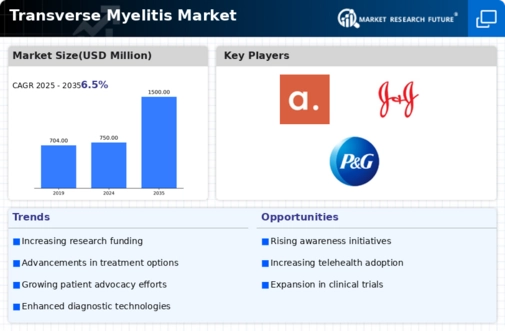Advancements in Diagnostic Techniques
The Transverse Myelitis Market is experiencing a notable shift due to advancements in diagnostic techniques. Enhanced imaging modalities, such as MRI and CT scans, have improved the accuracy of diagnosing transverse myelitis, allowing for earlier intervention. This is crucial, as timely diagnosis can significantly impact patient outcomes. Furthermore, the development of biomarkers is paving the way for more precise identification of the condition. As diagnostic capabilities improve, healthcare providers are better equipped to manage and treat patients, potentially increasing the demand for therapeutic options within the Transverse Myelitis Market. The integration of artificial intelligence in diagnostic processes also holds promise, as it may streamline patient assessment and enhance clinical decision-making.
Enhanced Patient Support and Advocacy
The role of patient support and advocacy organizations is becoming increasingly prominent within the Transverse Myelitis Market. These organizations are dedicated to raising awareness, providing resources, and advocating for research funding. Their efforts are instrumental in educating both patients and healthcare professionals about transverse myelitis, which may lead to earlier diagnosis and treatment. Furthermore, these organizations often collaborate with researchers and pharmaceutical companies to facilitate clinical trials and improve access to new therapies. As patient advocacy continues to grow, it is likely to influence the direction of research and development in the Transverse Myelitis Market, ultimately benefiting patients through enhanced treatment options and support.
Rising Incidence of Autoimmune Disorders
The rising incidence of autoimmune disorders is contributing to the expansion of the Transverse Myelitis Market. Transverse myelitis is often associated with autoimmune conditions, and as the prevalence of these disorders increases, so does the number of individuals affected by transverse myelitis. Epidemiological studies indicate a growing trend in autoimmune diseases, which may lead to a higher demand for effective treatments. This correlation suggests that as more patients are diagnosed with autoimmune disorders, the Transverse Myelitis Market will likely experience increased attention from healthcare providers and pharmaceutical companies alike. Consequently, this trend may drive innovation and investment in therapeutic solutions tailored to this patient population.
Growing Investment in Research and Development
Investment in research and development is a driving force within the Transverse Myelitis Market. Pharmaceutical companies and research institutions are increasingly allocating resources to explore novel treatment modalities, including immunotherapies and regenerative medicine. This surge in funding is likely to lead to the discovery of innovative therapies that could transform the treatment landscape for transverse myelitis. According to recent data, R&D spending in neurology has seen a significant uptick, reflecting a broader commitment to addressing unmet medical needs. As new therapies emerge from this investment, the Transverse Myelitis Market may witness a corresponding increase in treatment options available to patients, thereby enhancing overall market growth.
Technological Innovations in Treatment Delivery
Technological innovations in treatment delivery are poised to reshape the Transverse Myelitis Market. Advances in drug delivery systems, such as targeted therapies and personalized medicine, are enhancing the efficacy of treatments for transverse myelitis. These innovations may allow for more precise administration of therapies, potentially improving patient outcomes. Additionally, the rise of telemedicine is facilitating access to specialists for patients who may be geographically isolated. This shift in treatment delivery methods is likely to expand the reach of therapeutic options available to patients, thereby influencing the overall dynamics of the Transverse Myelitis Market. As technology continues to evolve, it may play a crucial role in shaping future treatment paradigms.

















Leave a Comment